Down from the clouds: Early aviation in Queensland prior to World War Two
By Christina Ealing-Goldbold, Research Librarian, Library and Client Services | 10 June 2023
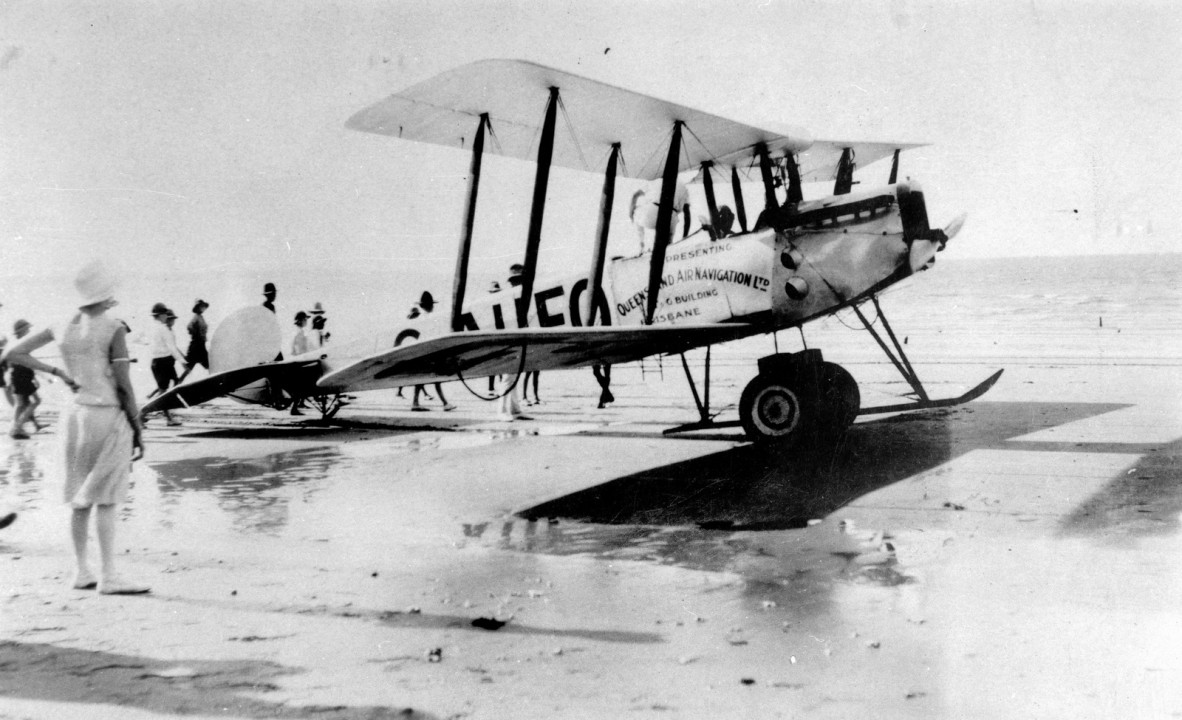
Beach landing for an Avro at Urangan, ca. 1928, State Library of Queensland, Negative number: 10765
Would you like to see the first Qantas Log Book from the 1920s? Perhaps you would like to trace an early plane by its registration number using the collections of the State Library of Queensland. Who were the courageous aviators who bought our commercial air services to life?
The development of aviation in Queensland is a story filled with courage and ingenuity, where large distances with no landing or refuelling facilities mitigated against the successful operation of services using flimsy small wooden aircraft.
Aviation came to Queensland primarily after World War One, with numerous forays into fledgling airlines and service provision. While the Qantas story has been frequently told, there were other initial air services. Each aviator and plane vied for the joy riding public as well as for the Royal Mail contracts that came with continuing Government funding.
State Library of Queensland has a range of resources to document the introduction of aviation in the state of Queensland. Besides the first Qantas logbook, there are wonderful images of each of the early aircraft (mostly Avro) filed by their Australian registration number. Australian registration in the 1920s began with G-Au. It was not until 1929 that the more familiar VH registrations began.
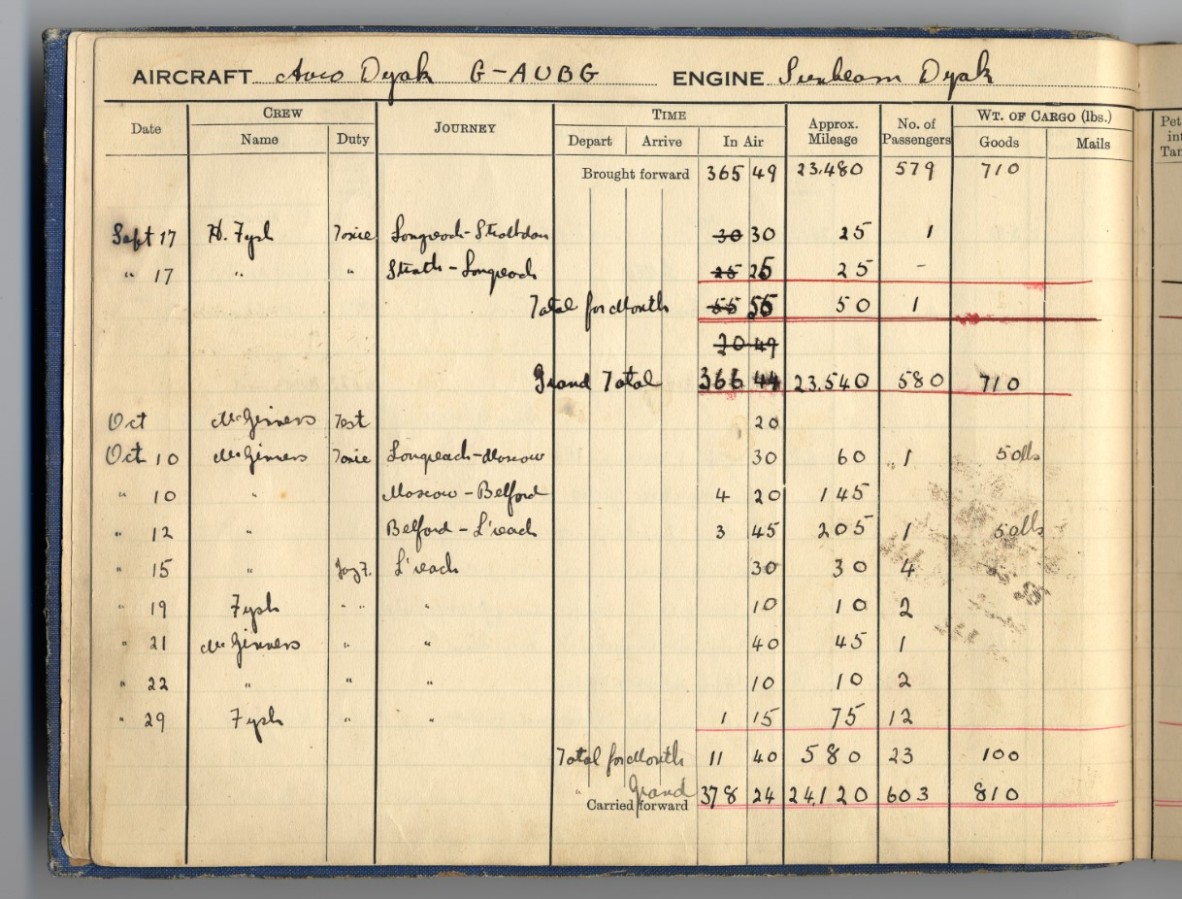
4117, QANTAS Log Book, John Oxley Library, State Library of Queensland
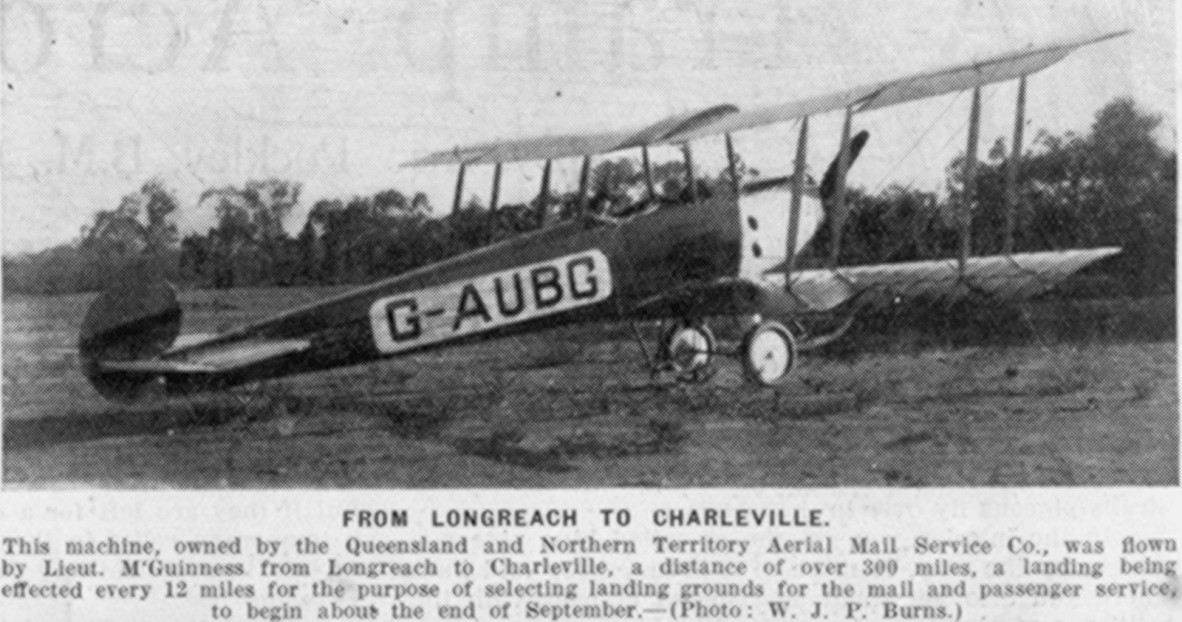
Biplane used to deliver the mail and passengers between Longreach and Charleville, 1922, State Library of Queensland, Negative number: 189586
In the beginning
The aeroplanes of the decade following the First World War were primarily wooden biplanes and occasionally, triplanes. With room for just a pilot and at most, two passengers, the little planes landed on racecourses and beaches all over Queensland. Kedron and Albion racecourses in Brisbane were commonly used for not only take-off and landing, but also as a place to offer joy rides. The planes of the day were made by Bristol, Handley Page, De Havilland and Sopwith as well as in the factory of Alliott Verdon Roe (A.V.Roe) in England. These planes dominated the skies in the 1920s and Avros were most popular of all. According to Captain J.H.Treacy, one of the pioneer pilots, the British War Office chose the Avro as the training plane for their pilots because of their safety and stability.
Mostly using Avro biplanes (made in England, and shipped to Australia) after World War One, pilots such as Captain Treacy, Lieutenant Roberts, Captain Snell and Lieutenant Bird proved their skill at landing and take off on beaches and racecourses in Brisbane, at Southport, Maroochydore and points further north and west. Joy rides on the beaches provided an initial opportunity for aviators to use their World War One flying skills in the local environment. The key to success was landing and taking off on firm sand. Unfortunate deviations into soft sand had some undesirable outcomes, with one plane being buried nose deep on Kings Beach Caloundra. Local fishermen had to use their boats to float it to northern Bribie Island to find a sufficient runway of firm sand to allow the plane to take off.
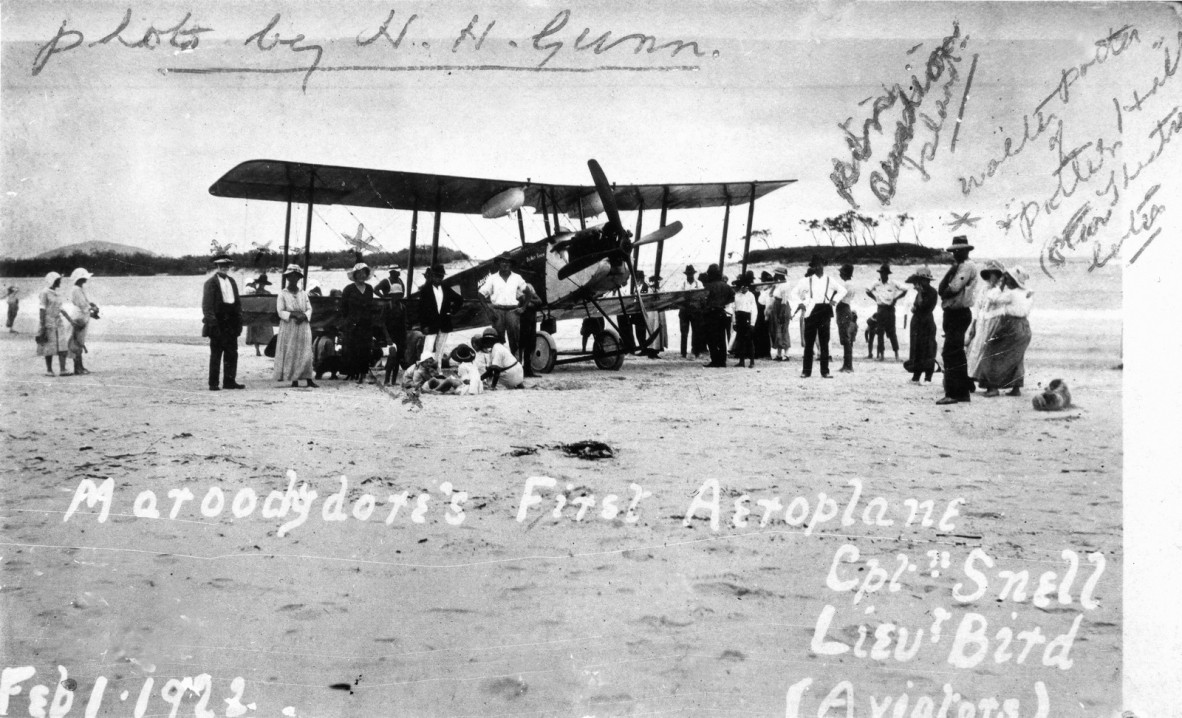
Maroochydore's first aeroplane, 1922, H.H. Gunn, State Library of Queensland, Negative number: 61976
Many of these aviators had their training in the sands of the Middle East in World War One, trained by the RAF to fly in sandstorms and hot climates. In fact, an Australian Aviator, Frank McNamara won the Victoria Cross in 1917 for his efforts flying a B.E.2c Bristol plane in Gaza. Included in the group of pioneer aviators in Australia were the founders of Qantas (Hydson Fysh, Fergus McMaster and Lt. Paul McGuinness) as well as Keith and Ross Smith, Bert Hinkler, Charles Kingsford Smith and Charles Ulm among others.
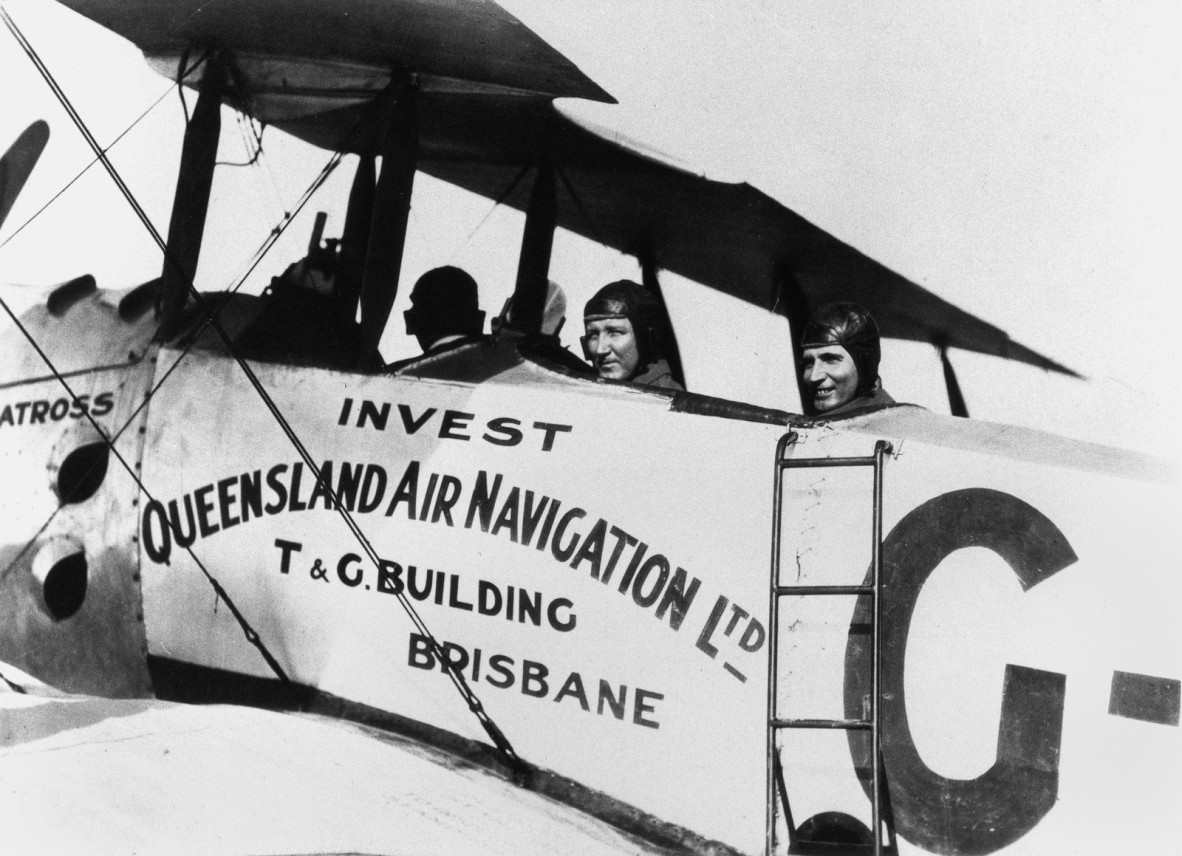
Captain J.H.Treacy at the controls of the Avro aeroplane “Albatross” with two passengers suitably attired for withstanding wind and climatic elements. Goggles would also have been worn once the plane took off.
Albatross with pilot Jack Treaty at the controls, ca. 1928, State Library of Queensland, Negative number: 60446
Competitions and air races lured those with the adventure spirit to be the first to travel great distances and establish air routes. Establishing the air routes was fraught with the difficulty of finding landing places sufficiently spaced to enable the planes to safely land when fuel and provisions were needed. Hudson Fysh (Qantas), driving a heavily loaded Ford vehicle surveyed landing places from Darwin to Melbourne to enable places for the competing aviators to land. Some landing places were on pastoral stations and many yards of white calico were provided to pastoralists so that they could map out the landing place to enable it to be easily seen from above. Lighting fires and using flares was also a useful way of ensuring that the pilot could see where he could safely put the plane down.
A series of firsts
The first to fly solo from Britain to Australia was Queensland’s Bert Hinkler, in an Avro machine, In 1921, Hinkler was the first to fly from Sydney to Bundaberg in a “Baby Avro”, taking a little more than 8 hours for the journey.
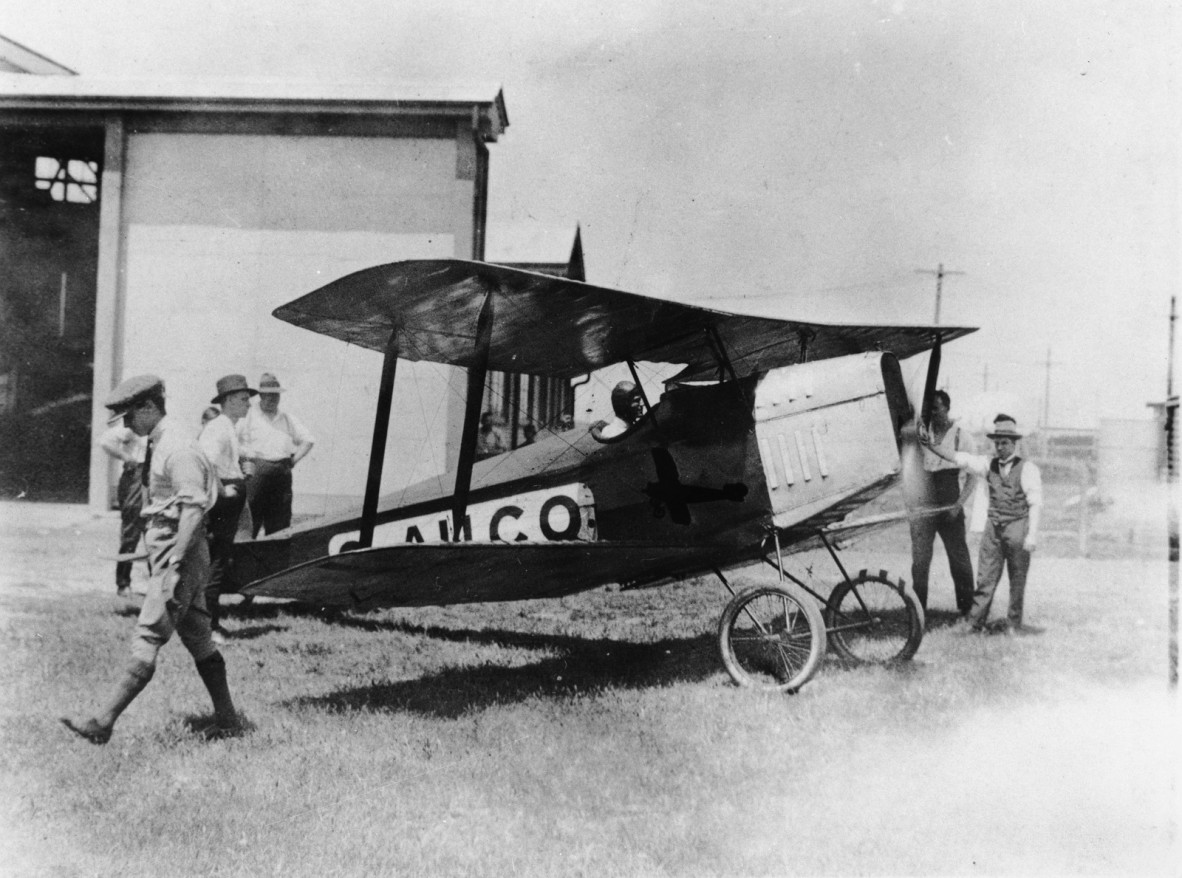
Bert Hinkler's Baby Avro aeroplane, G-AUCO, State Library of Queensland, Negative number: 168738
Sir Charles Kingsford Smith and Charles Ulm were the first to fly from North American to Australia. His early planes were also made by Avro and were the model 504K. Most of the early aeroplanes used to fly mail runs and provide joyrides in Queensland were Avro 504K models.
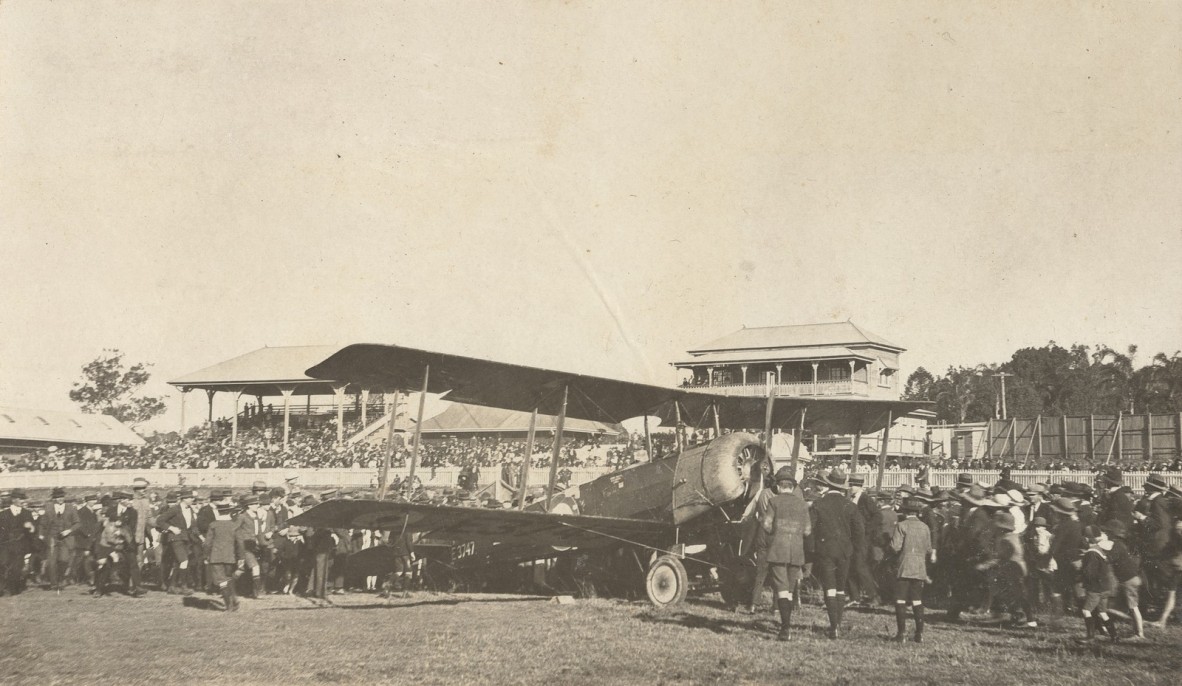
Avro biplane belonging to Sir Charles Kingsford Smith at Kedron race course, State Library of Queensland, Image number: 27189-0001-0014
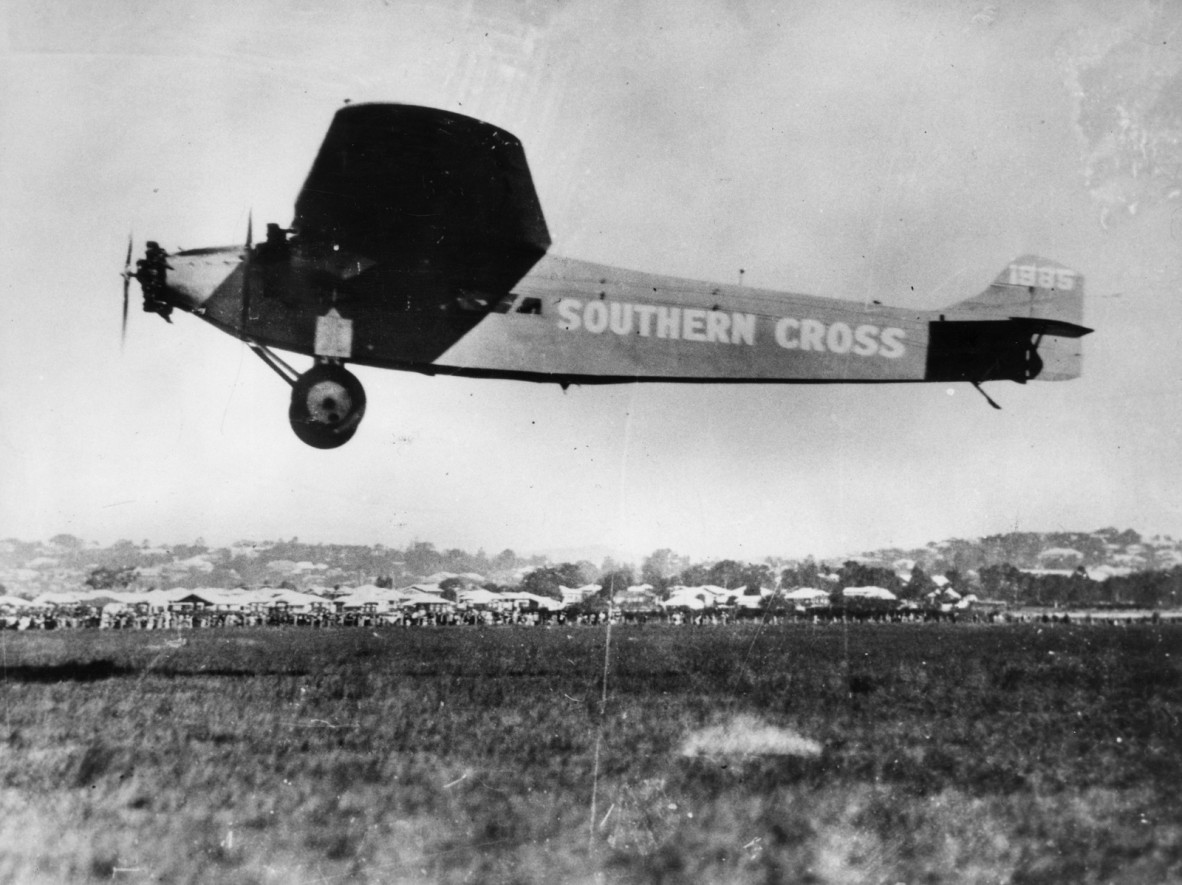
Landing the aircraft, Southern Cross in Brisbane, Queensland, ca. 1928, State Library of Queensland, Negative number: 68924
There were also successful female pilots in the inter war period who completed “firsts”, namely Amy Johnson (the first woman to fly solo from England to Australia in 1930) and Maude Lores Bonney. In 1933, Queenslander Lores Bonney flew from Brisbane to Croydon in the UK, the first woman to fly from Australia to England.
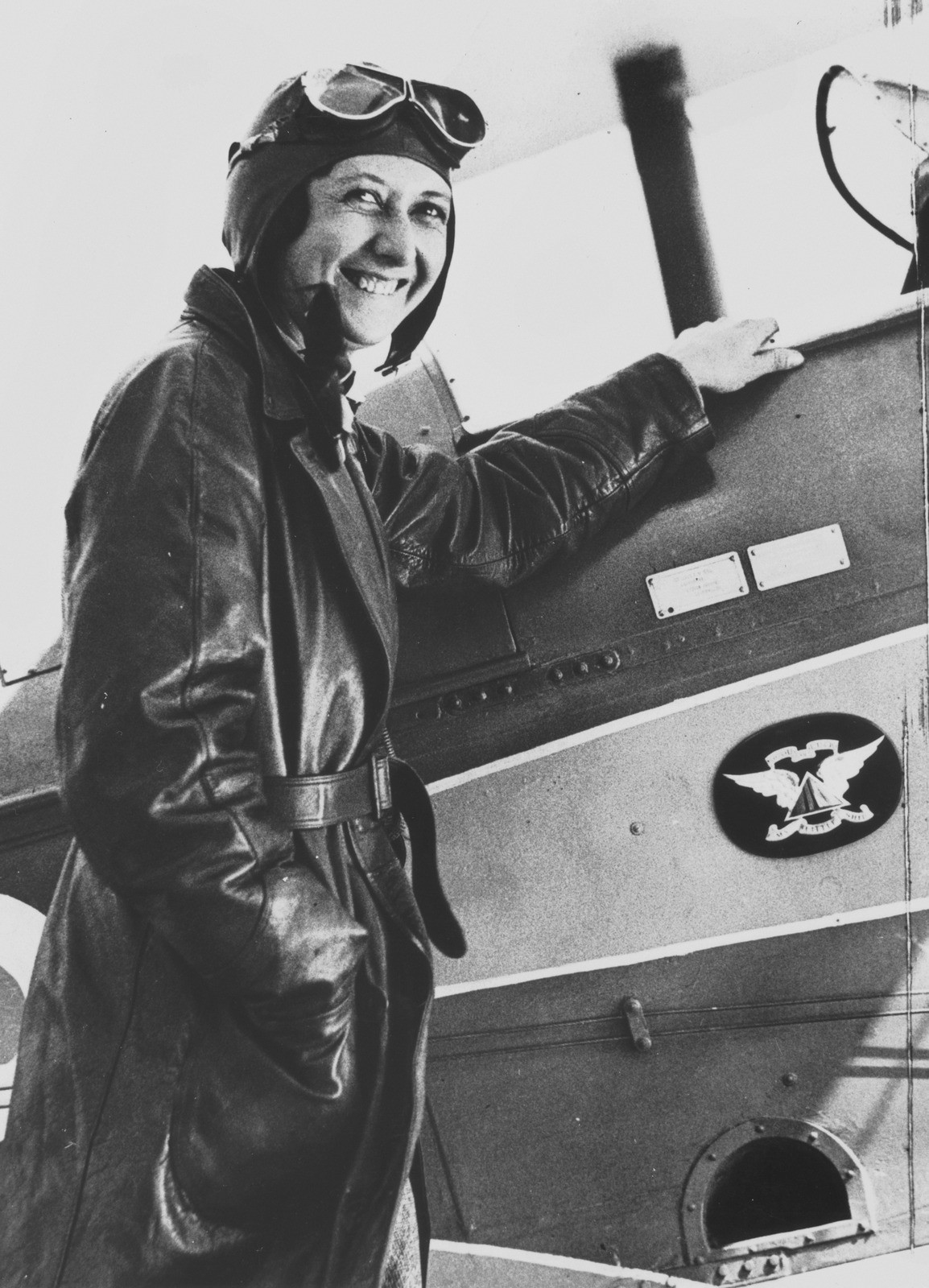
Aviatrix Lores Bonney boarding her Gypsy Moth at Charleville, ca. 1933, State Library of Queensland, Negative number: 49962
Innovative uses of aeroplanes
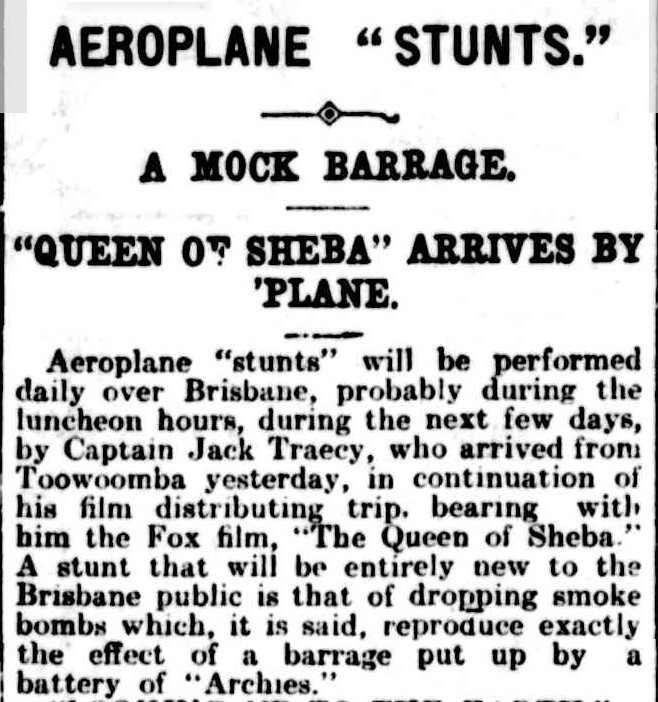
AEROPLANE "STUNTS." (1922, December 23). The Brisbane Courier http://nla.gov.au/nla.news-article20592067
In addition to mail delivery, joyflights and transporting courageous pastoralists over long outback distances, there were some innovative uses of the Avro planes. One interesting use was the delivery of films to towns and cities in Australia to make sure the latest blockbuster could quickly be shown everywhere. The film “Queen of Sheba” was delivered in this way in 1922, with Captain J.H.Treacy at the controls. Treacy was from Wagga Wagga in NSW and had flown in World War One. The Avro plane was named “Queen of Sheba”. Another use was also innovative - News copy and photographs were flown interstate to make the newspaper deadlines of other locations.
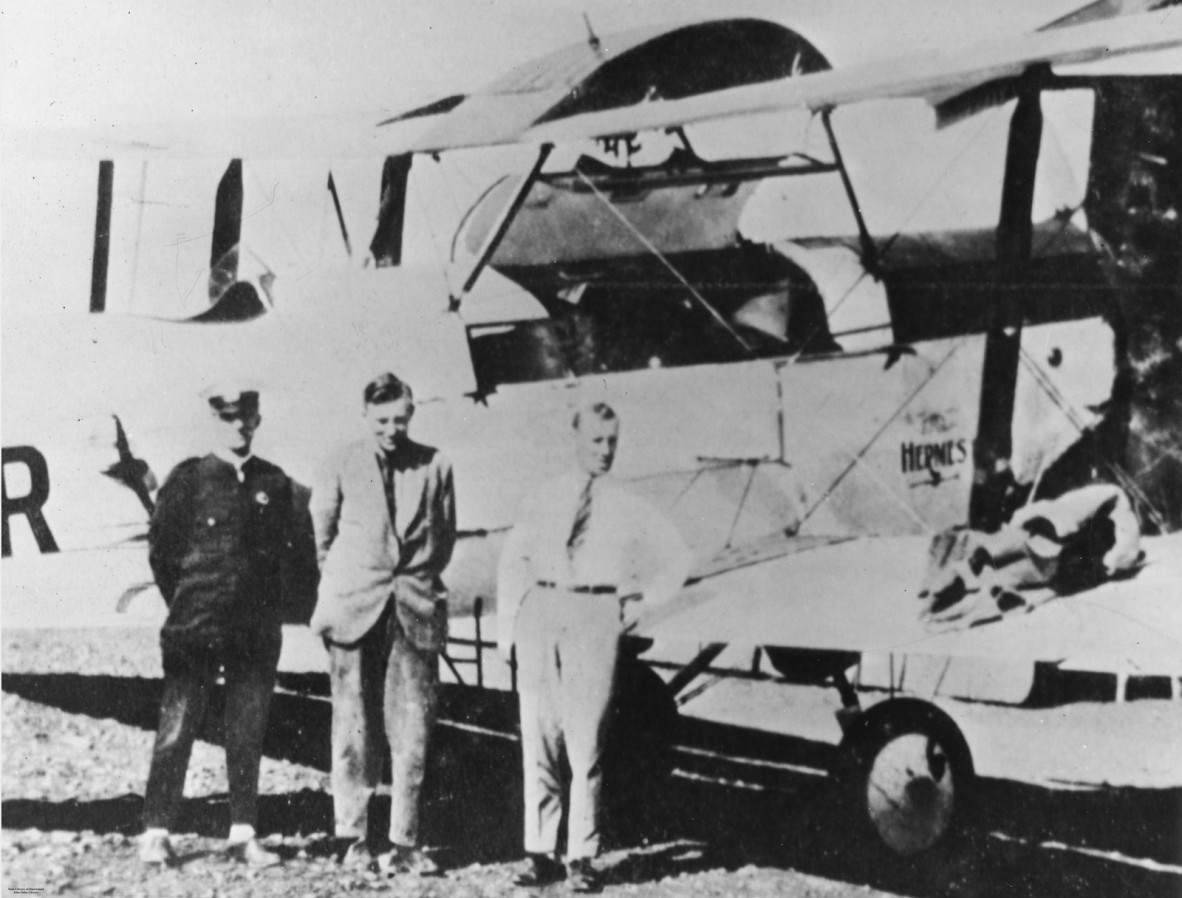
Dr George Simpson (centre) with Qantas pilot Mr Evans (right) and an official of the Queensland Ambulance Transport Brigade during Simpson's visit to Cloncurry in 1927.
Royal Flying Doctor Service, Cloncurry, 1927, State Library of Queensland, Negative number: 68748
Medical aeroplane services were considered as early as 1922. The advantage of the easier and quicker travel over long isolated distances was obvious. However, the comfort for the patient was another issue. The Flying Doctor Service began regular operations in 1928.
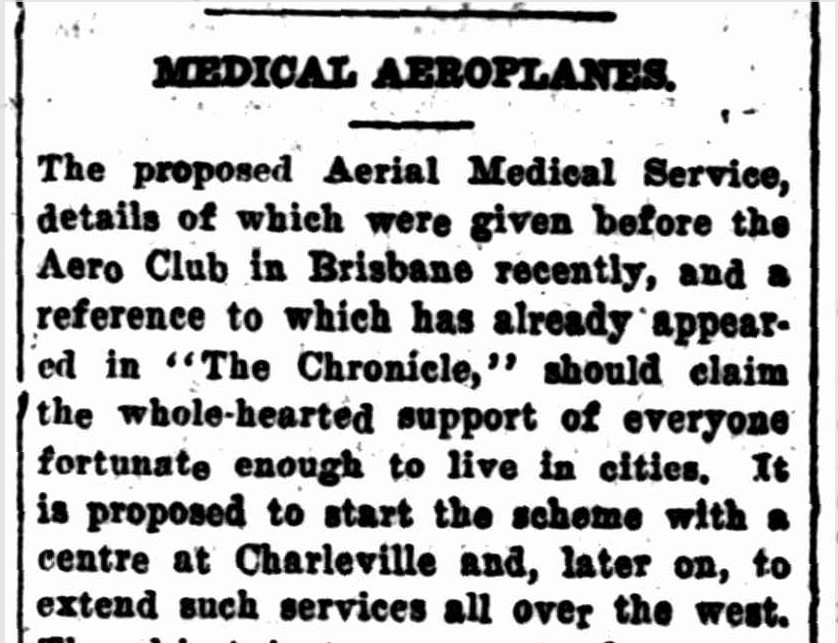
MEDICAL AEROPLANES. (1922, February 10). Toowoomba Chronicle http://nla.gov.au/nla.news-article253319445
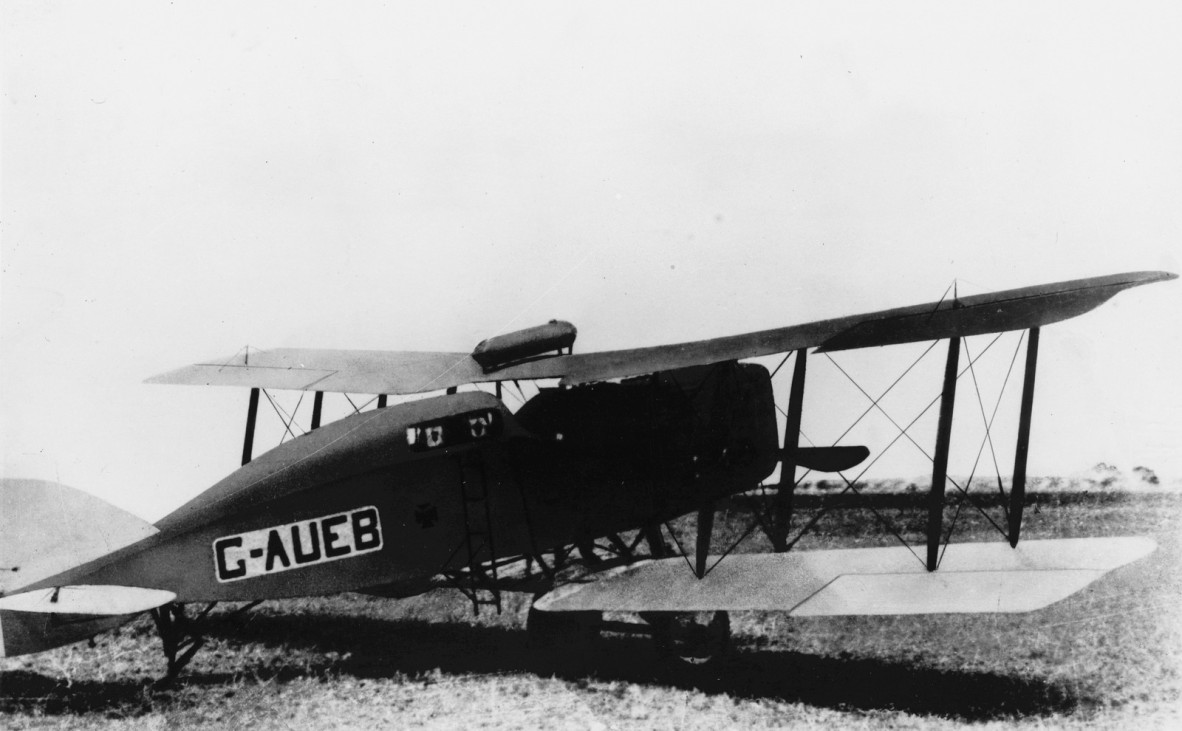
G-AUEB, Bristol Freighter aeroplane, which was used as an ambulance, ca. 1924, State Library of Queensland, Negative number: 194173
Commercial aviation
The closing years of the 1920s bought an interest in commercial flights between the major cities. In 1930, the flights of the “Southern Sun” and “Southern Sky” and other Avro planes began to operate from Brisbane to Sydney. Leaving Brisbane at 8am, the little planes carried 7 passengers and a pilot and spent all day in the air, arriving in Sydney by mid- afternoon. The price was somewhat exorbitant and only company accounts could afford the fare: 9 pounds and 13 shillings one way. When a working man with good wages made 2 to 3 pounds per week, the price of a one- way ticket must have seemed expensive indeed, and one risked life and limb for the privilege. Early flights left from Eagle Farm. However, after 1931 and through to 1949, Commercial Aviation was operated from Archerfield Airfield.
The first flight by Australian National Airways had no other than Sir Charles Ulm at the controls. Unfortunately, having passed over the McPherson Ranges, the weather was heavy with rain and wind gusts and the aircraft had to make a landing at Bonalbo, in a cow paddock. All were safe although the “machine” sustained some damage and had to be railed to Mascot for repairs. The passengers and Charles Ulm were driven to Kyogle and then travelled by train to Sydney the next day. However, the Royal Mail was collected by another small craft and flown to Sydney that very afternoon. The mail came first.
At 8am on the same morning the “Southern Sky” left Eagle Farm bound for Sydney. It was piloted by Messrs. Ulm and Sheppard and carried seven passengers … also 379 letters. At 10.20 am a forced landing was made in the Kyogle district, as Bonalbo, due, according to Mr Ulm, to impossible weather conditions and bad visibility. The occupants were uninjured, but the machine struck an obstruction and sustained some damage. It may have to be dismantled and railed to Mascot for repair. The passengers, along with Mr Ulm, were motored 60 miles to Casino, where the night was spent, the party continuing to Sydney by rail next day. The mail was collected by Mr Chaseling, who flew per Gypsy from Coff’s Harbour on the morning after the mishap and took it down to Sydney in the early forenoon.
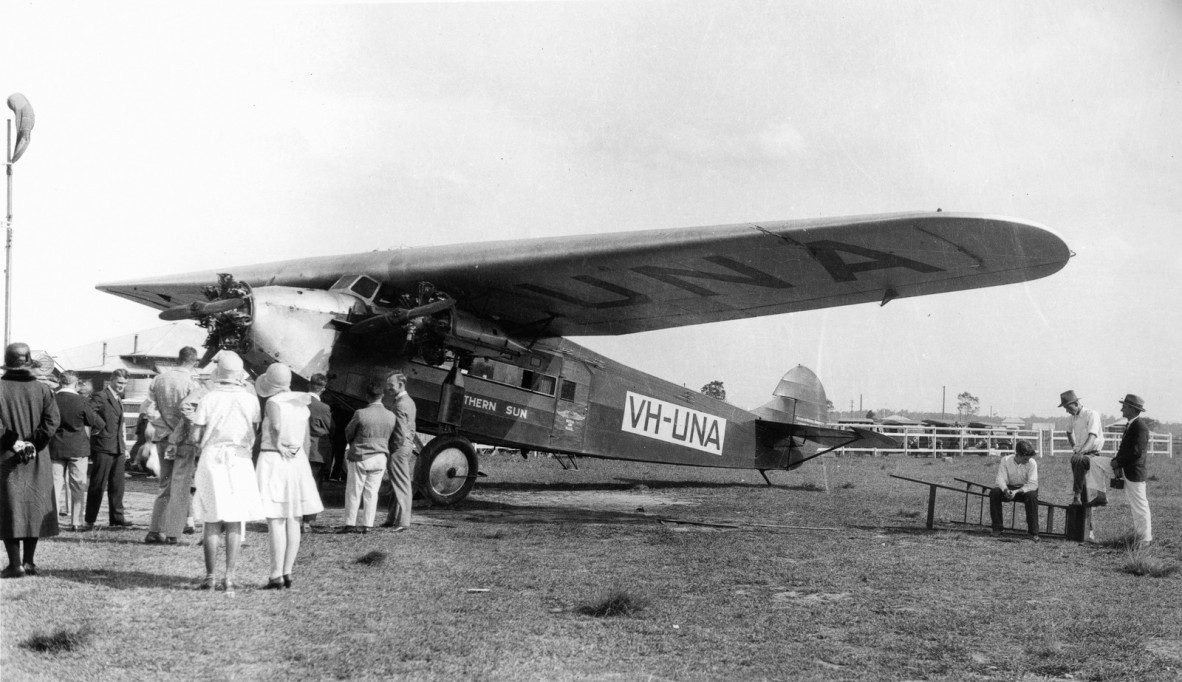
A ladder is at the ready to assist the passengers into the Avro “Southern Sun” at Eagle Farm in 1930.
Southern Sun, an Avro 618 Ten, ca. 1930, State Library of Queensland, Negative number: 60438
As well as books, photographs and log books, State Library has access to a number of early magazines detailing the various aircraft and services available. Aircraft, published in Australia from 1918 is available as a printed magazine at State Library and also on microfilm. Details of early commercial journeys, pilots and mishaps can call be found in this interesting publication. As was the custom of the day, aircraft are listed often by registration number. Commercial aviation saw the adoption of names such as the Southern Sky, Sun and Moon and Kyeema.
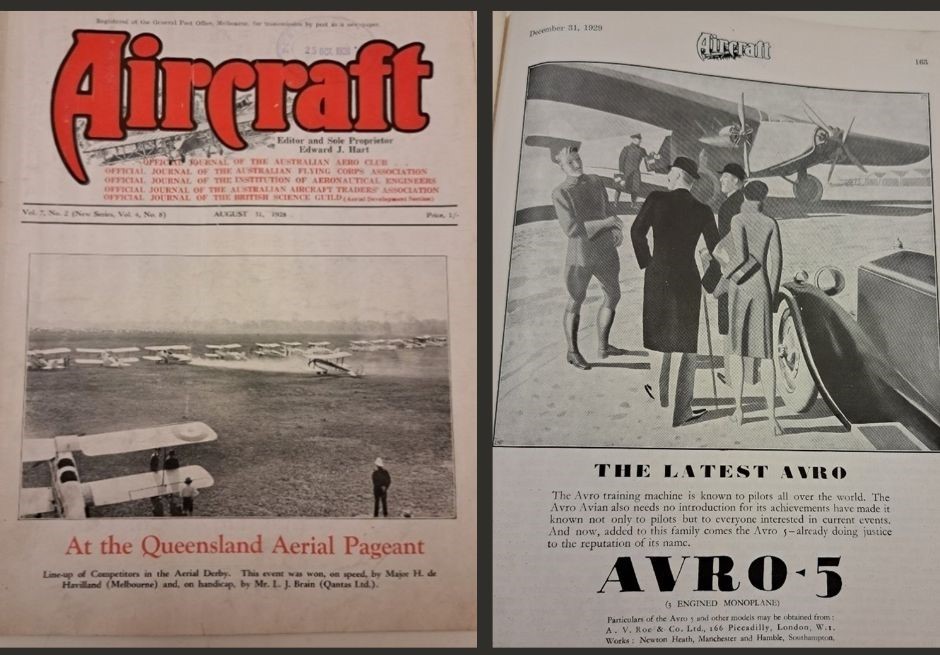
Left: Aircraft. Vol 7 no 2, August 31st 1928. Right: Aircraft. Vol 8 no 4, December 31st 1929, p163.
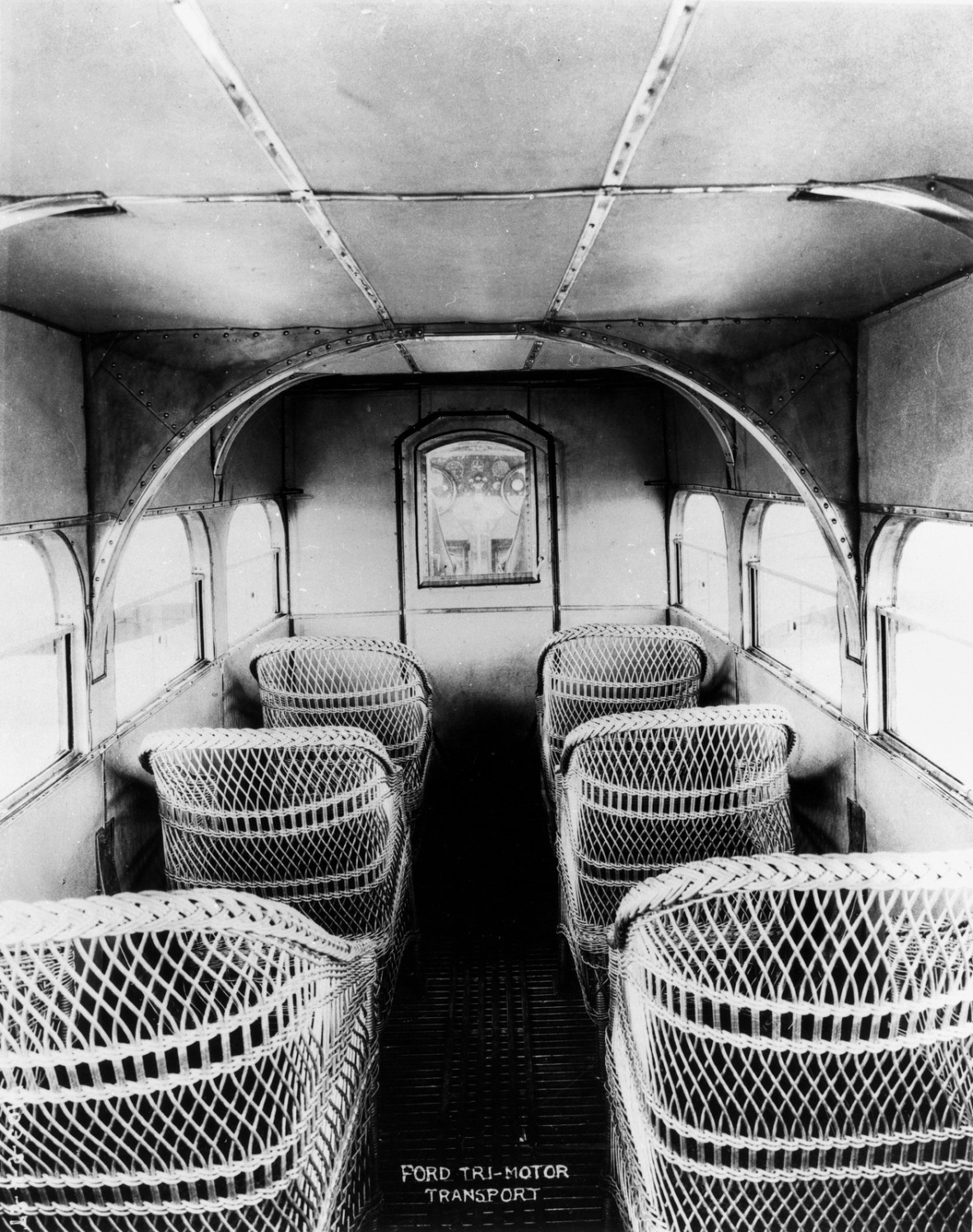
Cane seating in the cabin of a transport aeroplane. The instruments of the cockpit can be seen through the connecting door. Cane seating was light.
Interior of the Ford Tri-Motor Transport, ca. 1925, State Library of Queensland, Negative number: 22903
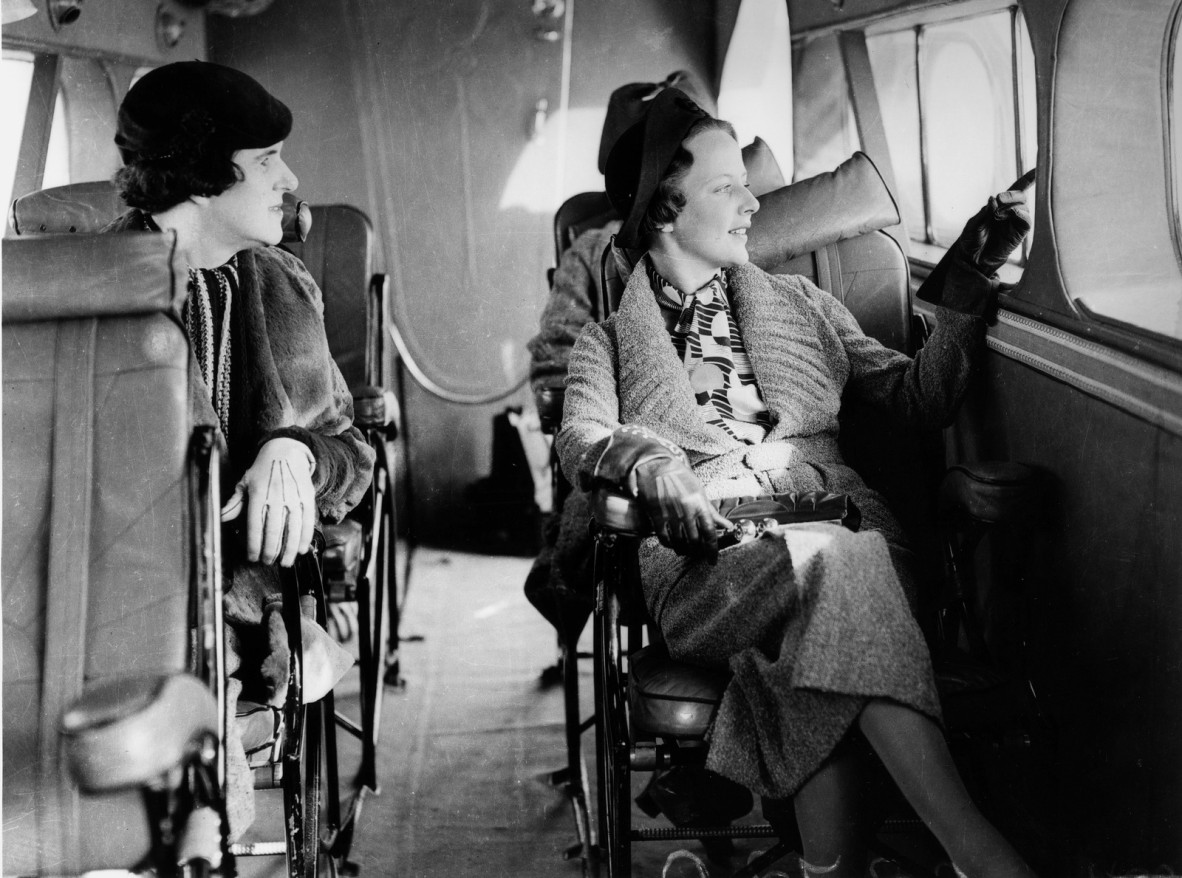
Interior of an aircraft for an autumn fashion segment in the Queenslander newspaper in 1936, State Library of Queensland, Negative number: 189432
Despite mishaps and accidents, commercial aviation grew, with Archerfield becoming the primary aerodrome in Brisbane for commercial flights.
Crashes and accidents
With such little aeroplanes and bush air strips, there were bound to be mishaps. However, as they carried only two or three people in the early years of aviation, the number of deaths was limited. Sadly, the expert airman, Bert Hinkler was killed in Italy, flying solo above the alps in 1933. He was mourned both in Queensland and internationally. The “Star of Cairns” crashed in 1930 killing both pilot and passenger. In 1934, a Qantas pilot, Norman Chapman and his two passengers were killed near Winton.
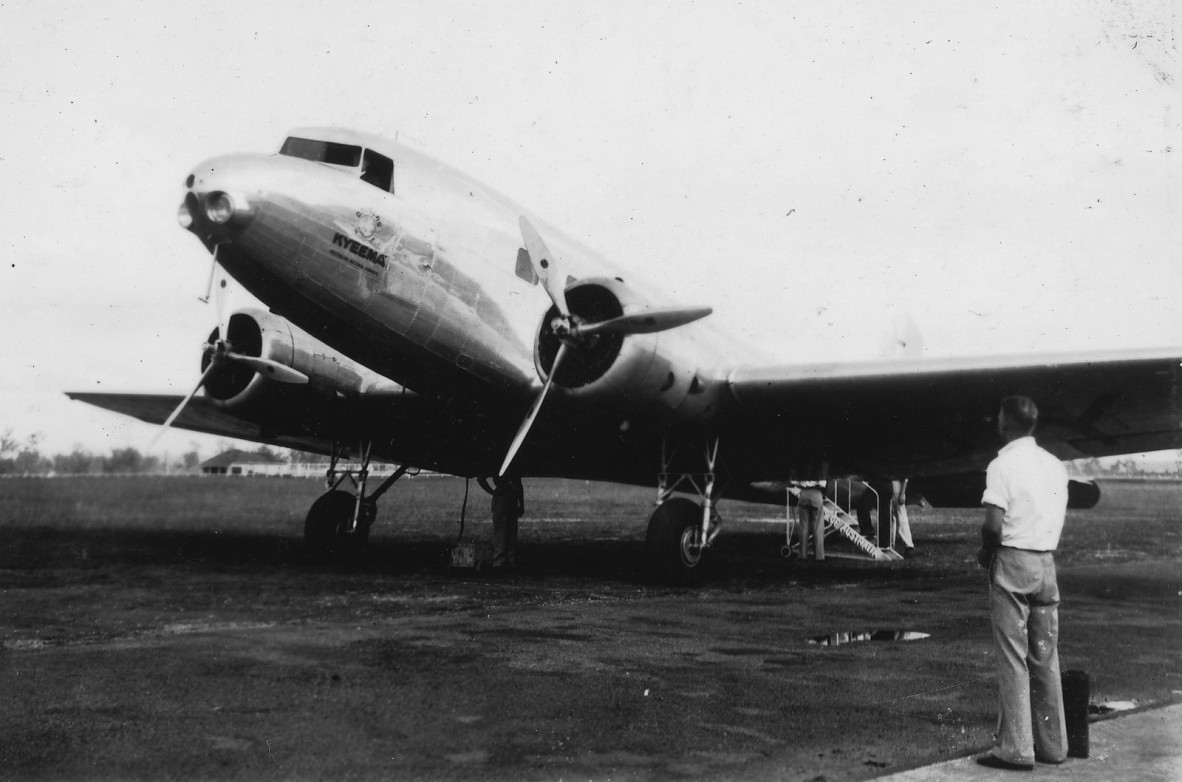
VH-UYC Douglas DC-2-210, which could carry 18 passengers, was registered on 30 July 1937 and named 'Kyeema'. The airline crashed near Mt. Dandenong on 25 October 1938. All lives were lost.
VH-UYC Douglas passenger aeroplane named Kyeema that flew between Brisbane and Sydney, State Library of Queensland, Negative number: 189543
The Stinson Crash of 1937 in the McPherson ranges was a commercial flight carrying 7 persons, including two pilots. There were two survivors. The crash proved to be of interest nationwide with a movie quickly made and circulated to the picture theatres. Well known bushman, Bernard O’Reilly used his expert bush skills to find the plane in the dense Lamington National Plateau and survivors were carried out on stretchers. This crash prompted the introduction of radio in airplanes. Another Stinson crash, also taking off from Archerfield in 1937 killed both pilot and passenger. Five were killed in a Dragon Rapide plane crash near Innisfail in North Queensland in 1938. The “Kyeema” crashed in the Dandenongs, Victoria in 1938 killing all 18 persons on board.
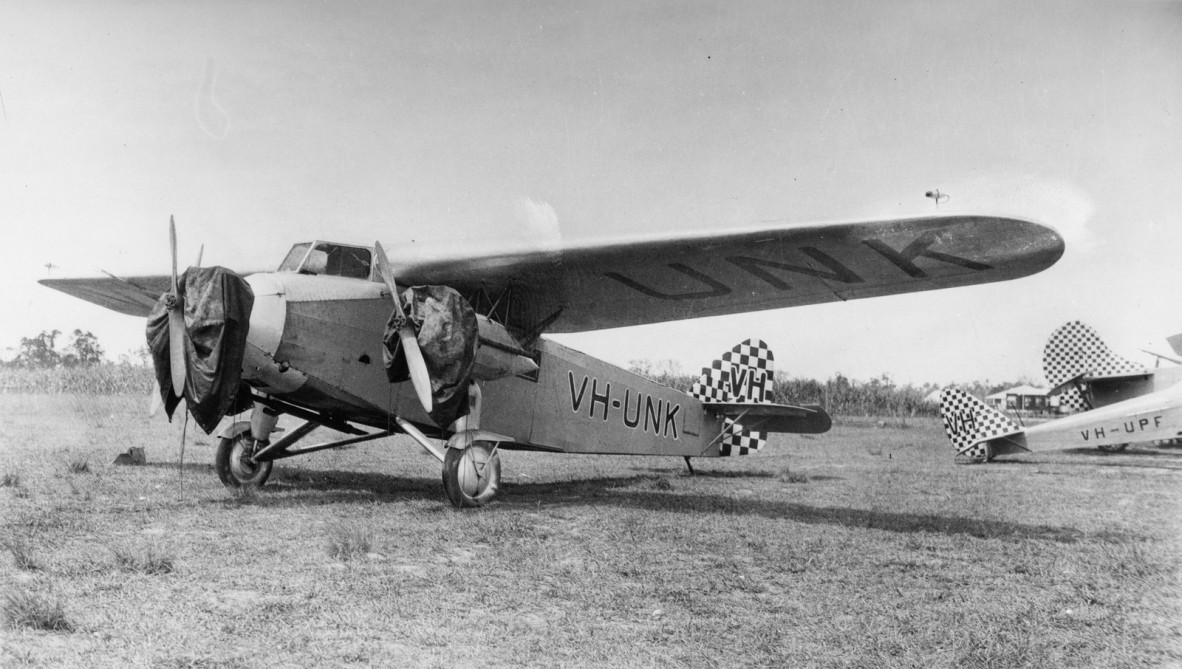
The Star of Cairns crashed in 1930 killing the pilot and passenger.
Star of Cairns, an Avro 619 Five, VH-UNK, ca. 1930, State Library of Queensland, Negative number: 60443
The development of seaplanes
During the late 1920s and 1930s, a new airport runway emerged in Brisbane – the Brisbane River! What would the convicts of one hundred years earlier have thought of these contraptions skimming the water in front of their Commissariat Store building?
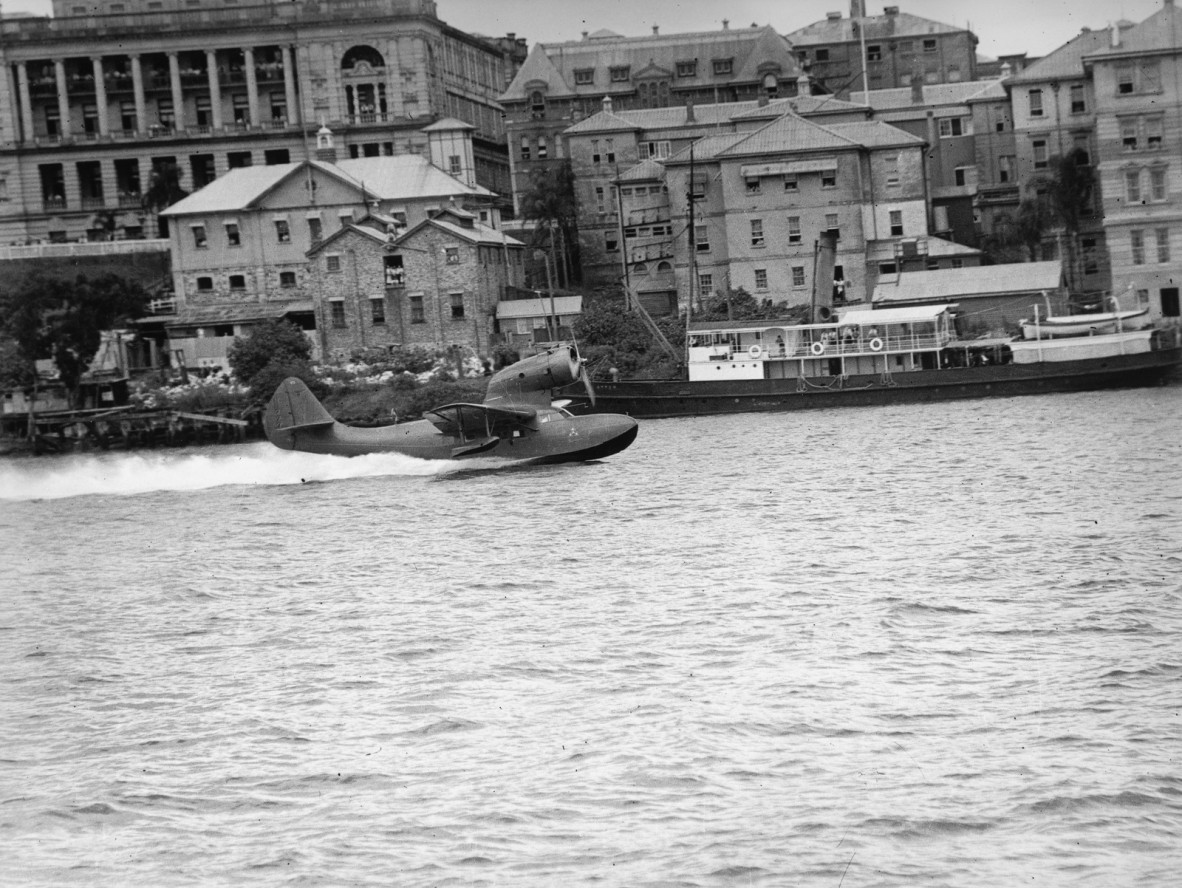
Seaplane landing on the Brisbane River, in front of the Convict built Commissariat Store and the Treasury Buildings.
Seaplane landing on the Brisbane River, ca. 1935, State Library of Queensland, Negative number: 189644
To develop international air services, the Flying Boats enabled the plane to touch down in many different environments and locations (rivers, oceans, ports) to cover the long journey from Sydney to London via Singapore.
The Short company in England made the giant Flying Boat seaplanes of metal. They became the luxurious way to travel from England to Australia. Three times a week, the Empire Flying Boats, carrying 24 passengers took off from Rose Bay in Sydney and landed on the Brisbane River near Hamilton and Pinkenba. They continued on to Singapore, taking three days for the journey. From Singapore, the Flying Boats took another 10 to 12 days to reach Britain. A ticket cost 195 pounds. Qantas purchased six of the flying boats initially. All the Flying boats had enchanting names, beginning with the letter “C”. One that regularly visited Brisbane was the “Cooee” and another was called the “Coolangatta”.
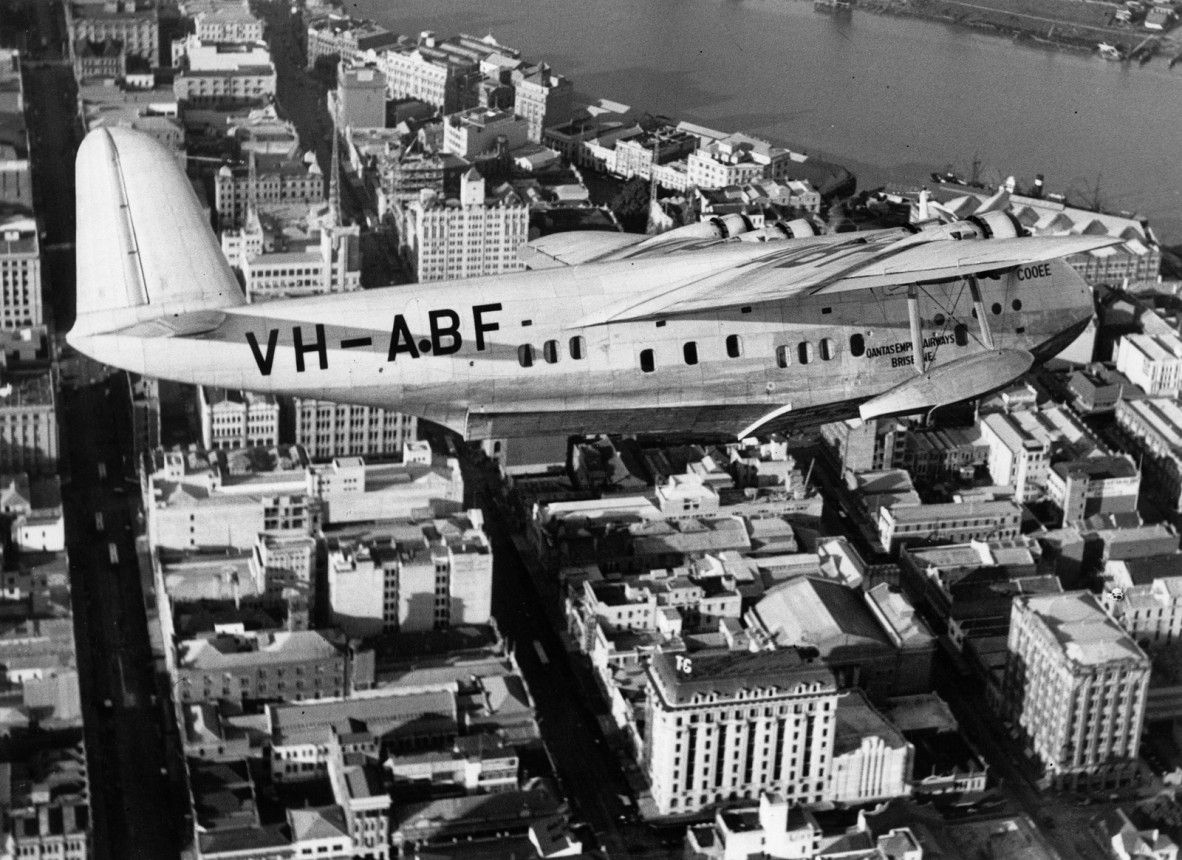
"Cooee" first landed in Brisbane on 5 July 1938 on its inaugural flying boat service to Singapore. The service was operated by QANTAS
Empire flying boat "Cooee", operated by QANTAS, circling over Brisbane, 1938, State Library of Queensland, Negative number: 60428
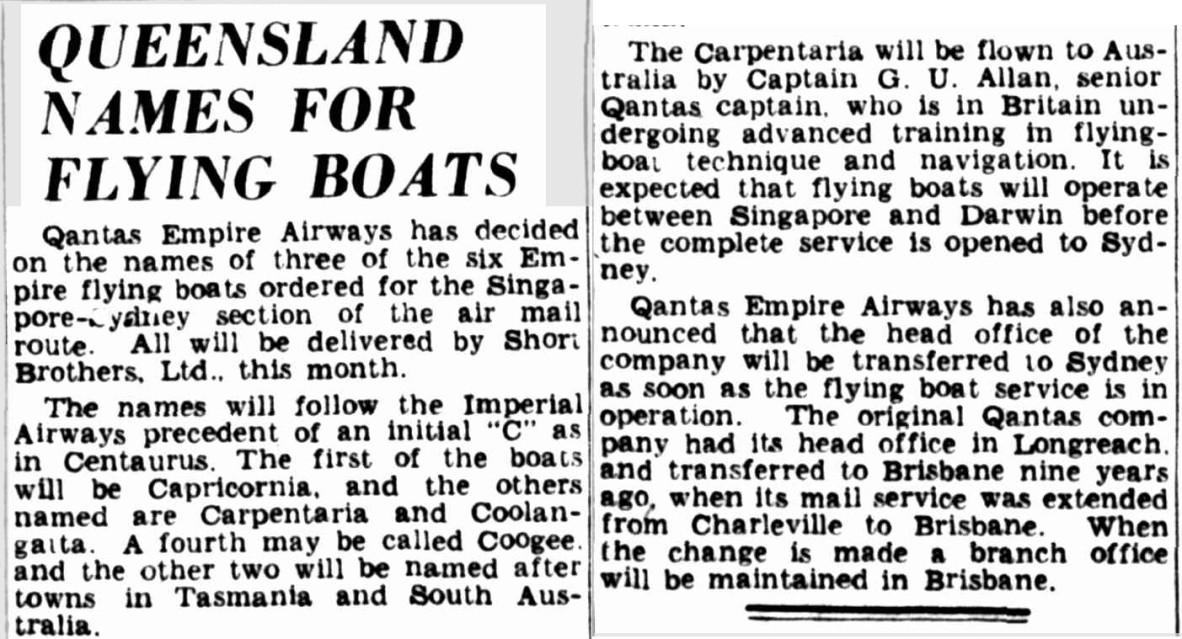
QUEENSLAND NAMES FOR FLYING BOATS (1938, January 4). The Courier-Mail p.14. http://nla.gov.au/nla.news-article39744921
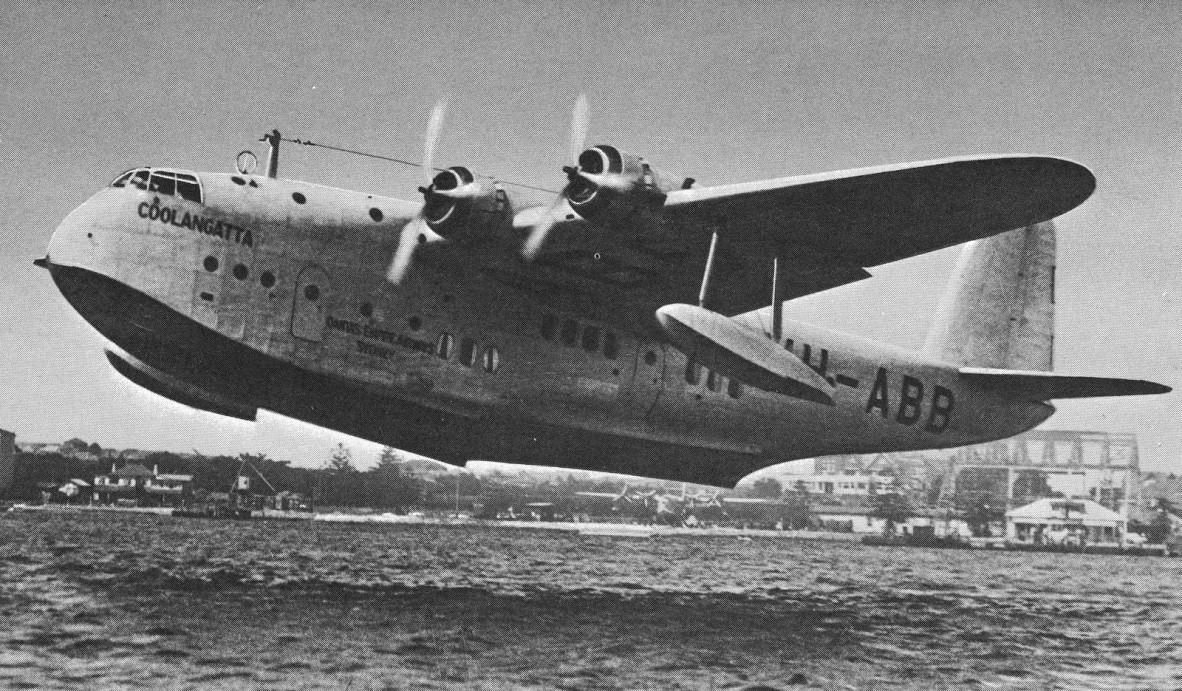
Empire flying boat 'Coolangatta' taking off, State Library of Queensland, Negative number: 189603
By 1939 Commercial air travel between major Australian cities was well established, as was the very expensive Qantas Empire air services, linking passengers and mail between Australia and Britain and other continents. The aeroplanes now had cabins for the passengers and some interior comfort. The aeroplanes were more robust and for the most part, safer than the earlier models of the 1920s and enabled a new era of faster transport over large distances.
World War Two brought many changes in aircraft design and capabilities. Some of the aircraft flown commercially in the 1930s were commandeered for military purposes, including the Empire Flying Boats. They were used for delivering supplies and bringing out injured personnel from New Guinea, Indonesia and other Pacific locations. In 1942 and 1943, soldiers were flown from Townsville to Milne Bay in the once luxurious Flying Boats. Eagle Farm became a busy airport used for Australian and American aircraft as did the nearby Brisbane River.
The courage of the newly trained airmen from World War One, flying small wooden aircraft over extensive Australian distances is to be commended for without their vision and tenacity, early aviation in Queensland and indeed across Australia would not have developed so quickly.
Down from the clouds, these primitive flying machines did indeed achieve the defeat of distance!
Selected resources
Books
The defeat of distance : Qantas 1919-1939 by John Gunn
Wings on the river : flying boats on the Brisbane River and Redland Bay David Jones
From the dawn of aviation : the Qantas story 1920-1995 by John Stackhouse
Bert Hinkler and the Avro Baby by Edward P. Wixted
Journals
Newsletter / Queensland Branch, Aviation Historical Society of Australia
Qld AHSA news / Aviation Historical Society of Australia Inc.
Journal / Aviation Historical Society of Australia
Original materials
Bert Hinkler's Procession Photographs 1928
Charles Kingsford Smith Souvenir Flight on "Southern Cross" joy flight ticket.
Noel Wright Aviation Cutting Book 1933-1936
Edwin Chapman Papers and Oral History 1930-2005
Major Thomas Macleod scrapbook
Audiovisual
QANTAS digital story and oral history : Queensland Business Leaders Hall of Fame 2009
More information
Plan your visit – https://www.slq.qld.gov.au/visit
What’s on at State Library – https://www.slq.qld.gov.au/whats-on
Library membership – https://www.slq.qld.gov.au/services/membership
One Search catalogue – https://onesearch.slq.qld.gov.au
Ask a librarian - https://www.slq.qld.gov.au/services/ask-librarian
Comments
Your email address will not be published.
We welcome relevant, respectful comments.